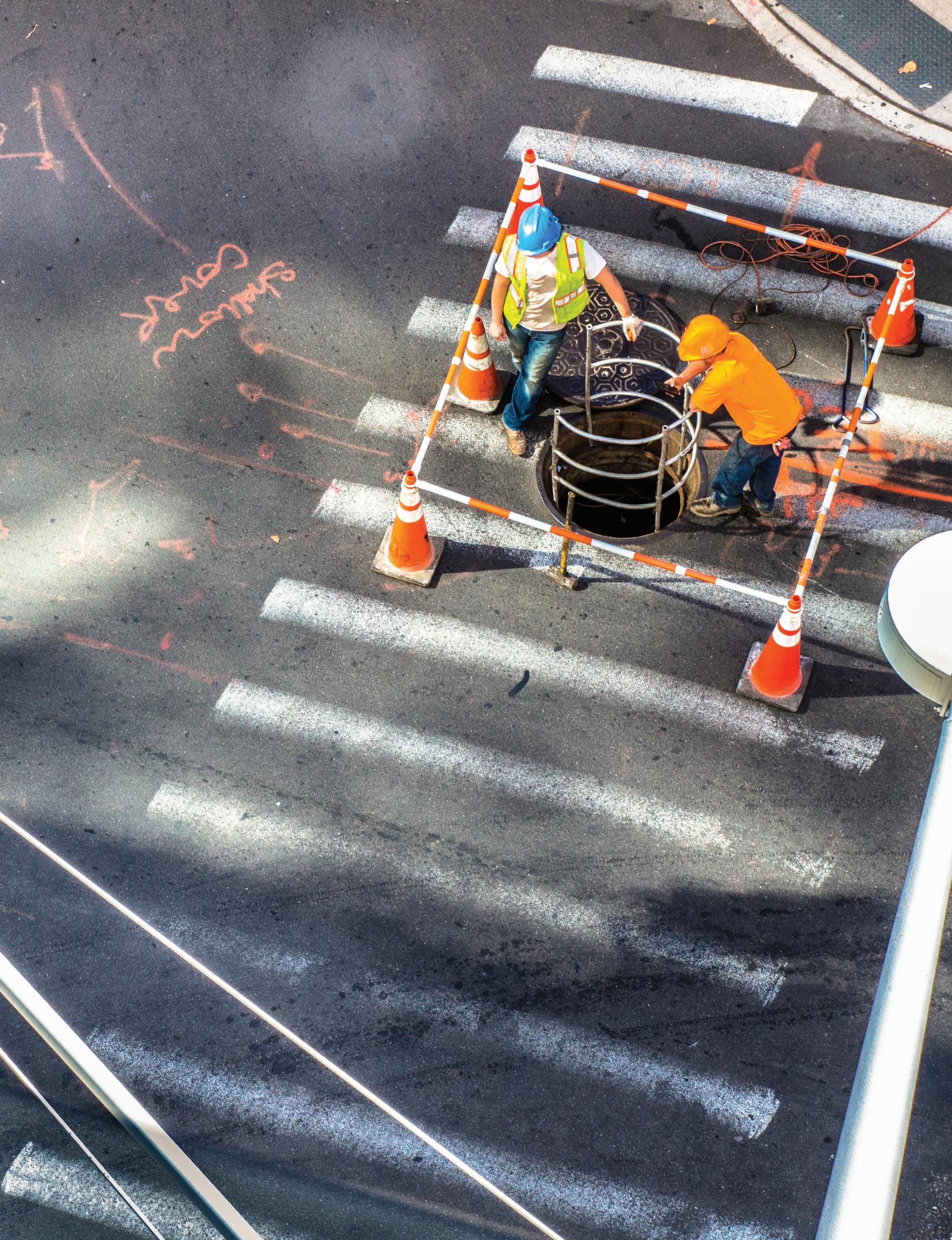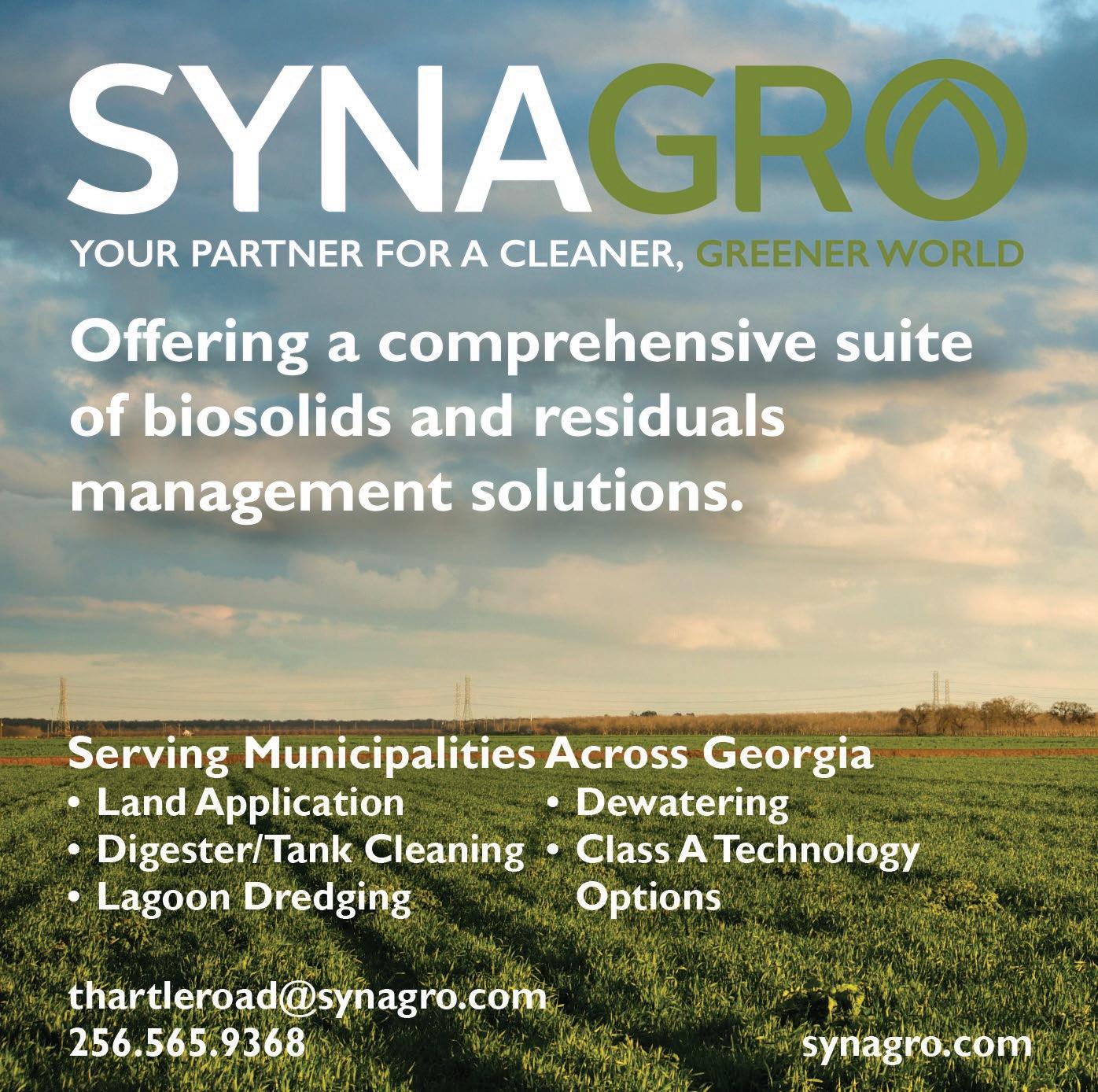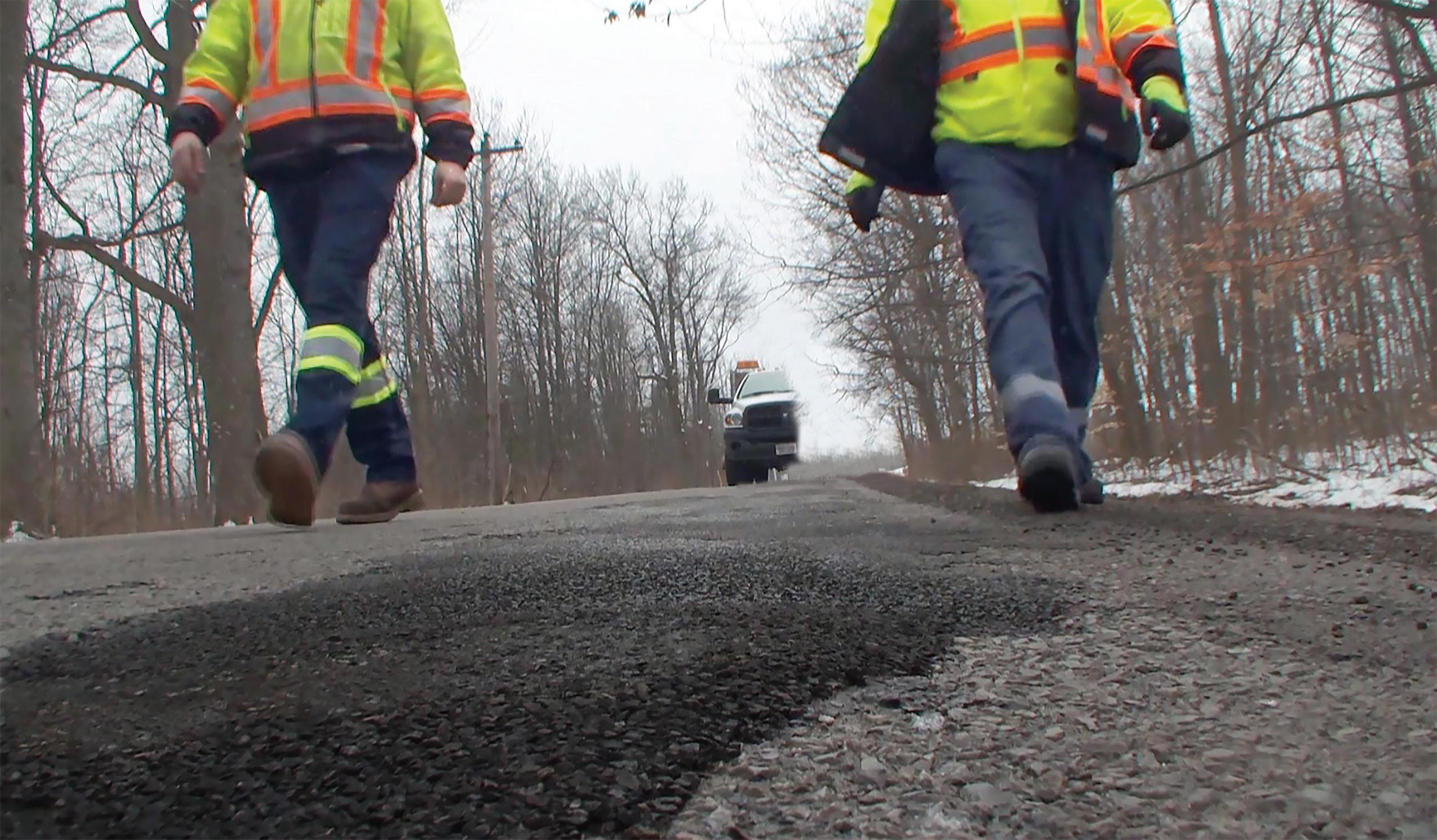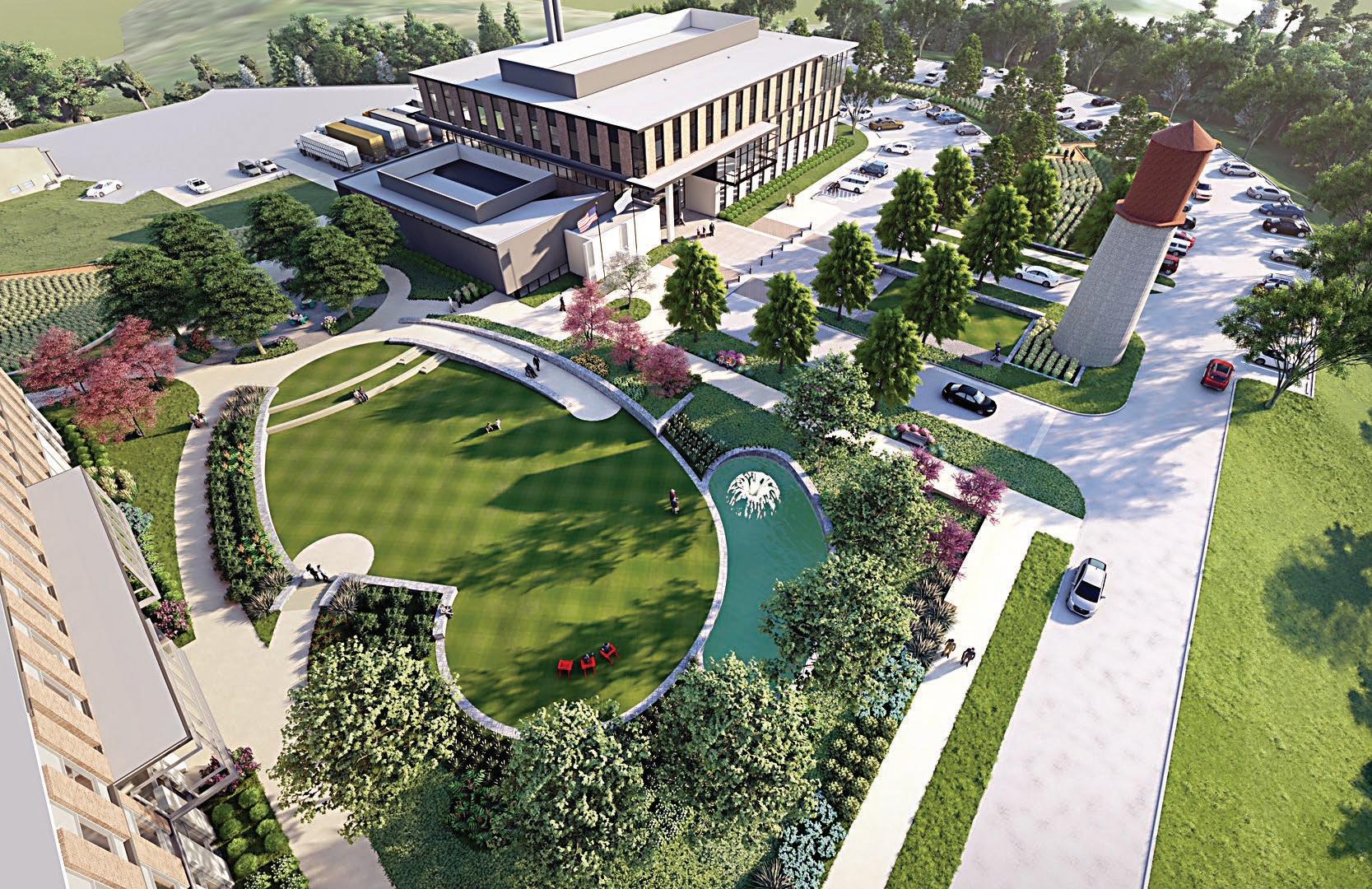
24 minute read
Let’s Talk About Confined Spaces
By Darrel West, Gwinnett County Department of Water Resources, By Darrel West, Gwinnett County Department of Water Resources, darrel.west@gwinnettcounty.com darrel.west@gwinnettcounty.com
When those of us who have been in the water and wastewater industry hear the words ‘confined space,’ we typically start thinking about our sewer systems, lift stations, or some less-than-ideally designed underground tank. Perhaps you have had the opportunity to be in a confined space, such as a sewer manhole, and thought to yourself, “Wow, this sure is a confining space I am in” and you would be correct. Personally, when I hear the words ‘confined space,’ I tend to think about areas that are dark, dingy, smelly, and have more than just a few cockroaches (even the occasional albino ones) living in there – all of whom are more than willing to run up your pant leg. Yes, tanks, pits, vaults, and manholes are all examples of confined spaces, but what makes them a confined space?
Any way we slice it, confined spaces are not exactly set up for hosting the

annual family picnic, but so what? “So the occasional roach runs up my pantleg and I get a little dirty – what’s the big deal?” Good question and glad you asked it. It’s simple – confined spaces have and unfortunately will, in all likelihood, continue to take the lives of either unsuspecting or recalcitrant entrants, period. To further compound the issue, in situations involving a fatality, there is mounting evidence that multiple fatalities are the norm.
If you have to work in and around an area that has the potential to take your life or the life of a co-worker, it makes sense to do a bit of a deep dive into understanding what to be on the lookout for, what the problems could be, and more so, how to either avoid or remove those associated challenges. I could tell you about any number of confined space fatality stories the search engine of your choice will spring to life on your computer screen as a shock and awe tactic, but rather have decided to honor those individuals by using this platform to educate, encourage, and inspire.
Let’s Start From the Beginning
The Merriam-Webster dictionary does not define a confined space. That’s right, you will not find the definition of a confined space in the dictionary. If we want to find the definition of a confined space we are going to have to peek into the Occupational Safety and Health Administration’s 29CFR 1910.146 or 1926.1203, otherwise known as the confined space standards for general industry and the construction industry respectively. For the duration of this article, we will be referring to Federal OSHA’s general standard for confined space entry.
The Occupational Safety and Health Administration (OSHA) defines a confined space as any area that: • Is large enough and so configured that an employee can bodily enter and perform assigned work
AND • Has limited or restricted means for entry or exit
AND • Is not designed for continuous employee occupancy Hopefully, you noticed that the word AND was both capitalized and in bold between each of the confined space criteria. The “ands” are very important. If an area exhibits only one or two of the key characteristics, then it cannot be a confined space – a confined space has all three characteristics.
Let’s break each of those criteria down a little for clarity’s sake.
Is large enough and so configured that an employee can bodily enter and perform assigned work. This one is straightforward and does not typically require much explanation.
Has limited or restricted means for entry or exit. This is how you get into and out of a space. If you get into the space via a ladder, manway, or mechanical hoist then the space has limited means for entry and exit. Essentially if there are any physical barriers that impede self-rescue (such as the absence of a standard industrial door or stairs), it likely represents a limited entry or exit situation.
Is not designed for continuous employee occupancy. Was the space built with people in mind? Typically, we are looking for lighting and ventilation. If the space has lighting and forced air ventilation, then it probably is designed for continuous employee occupancy. Other clues to indicate if the area was designed with people in mind include having a physical barrier such as pipes or walls and the area has adequate working space such that an employee can place feet on a floor without having to stand on pipes, pumps, equipment, etc.
Let me see if I can translate from “OSHAese” into a couple of real-world examples. Take for example a 10-foot-deep vault with metal rungs built into the concrete. Ask the three questions above to decide whether or not the area in question is a confined space. If you ask yourself the all-important three questions, your answer should be this vault is: • big enough for you to get into and work • is limit entry and exit (ladder) • not designed for employee occupancy (no lighting and ventilation) Therefore, it is a confined space.
On the flip side, my office is not a confined space. Sure, it is large enough and so bodily configured to enter (barely, but it is) so it meets the first definition of a confined space; however, my office does not have limited entry or exit (it has a standard industrial door) and it is designed for continuous employee occupancy (it has lighting and ventilation). My office only has only one of the three necessary characteristics – it is not, and by definition, cannot be a confined space.
Jumping to Permit-Required Confined Space
So, now that we are clear about what a confined space is, what is all this talk about danger and taking of lives? Another good question, glad you asked that one as well. Oftentimes, those same confined spaces have an associated hazard or multiple associated hazards simply because of the purpose of the space. A confined space with a hazard becomes what is commonly referred to as a “Permit-Required Confined Space.”
A Permit-Required Confined Space is a confined space with one or more of the following hazards: • Contains or has the potential to contain a hazardous atmosphere; OR • Contains a material that has the potential for engulfing an entrant; OR • Has an internal configuration that an entrant could be trapped or asphyxiated by inwardly converging walls or by a floor which slopes downward and tapers to a smaller cross section; OR • Contains any other recognized serious safety and health hazards. Hopefully, you noticed that the word OR was both capitalized and in bold between each of the hazards. When a confined space contains one of the four hazards categories, it is a Permit-Required Confined Space.
Let’s break each of these hazard criteria down for the sake of clarity.
Contains or has the potential to contain a hazardous atmosphere. The air you are breathing right now is about 20.9% oxygen, at least I hope it is. 20.9% can be thought of as the baseline when it comes to oxygen – ideally, if we are going to be breathing in a confined space (and breathing is good), we are shooting for that 20.9% oxygen number. While 20.9% is great, there is something called an acceptable range. OSHA defines that range as between 19.5% or as much as 23.5% oxygen. Anything below 19.5%

is an oxygen-deficient atmosphere which can lead to asphyxiation. If the atmosphere contains greater than 23.5% oxygen, the atmosphere is now oxygen-enriched which can create a flammable or explosive atmosphere. From there contaminants vary, however in the wastewater industry the most common contaminants of concern include carbon monoxide, hydrogen sulfide, and explosive gases such as methane.
Let’s start with carbon monoxide. Carbon monoxide is a colorless, odorless, tasteless gas. OSHA’s 29 CFR 1910.1000 table Z-1 lists the permissible exposure limit as 50ppm as an eight-hour time weighted average based on a 40-hour work week.
Methane is another colorless, odorless, tasteless gas. Methane also represents an explosion hazard. There are of course other flammable gases, vapors, and mists but in the wastewater industry, methane is common. Explosive gases, vapors, and mists should not exceed 10% of their lower flammable limit (LFL).
The final and very common gas in the water/wastewater utility industry is hydrogen sulfide. Hydrogen sulfide has a telltale rotten egg smell which can quickly overwhelm a sense of smell rendering a person with olfactory fatigue and the inability to detect the compound. The ability to detect returns in the vast majority after removal from the area. OSHA’s 29 CFR 1910.1000 table Z-3 lists the acceptable ceiling concentration for hydrogen sulfide at 20ppm.
While these are the most common gases analyzed in the water and wastewater industry, chlorine gas, as well as ozone, are other common gases which deserve mentioning and if appropriate, monitoring.
Contains a material that has the potential for engulfing an entrant. Materials that have the potential for engulfing an entrant include both liquids or flowable solids, such as lime or carbon. Oftentimes the removal of such material may be necessary for safe entry.
Has an internal configuration that an entrant could be trapped or asphyxiated by inwardly converging walls or by a floor which slopes downward and tapers to a smaller cross section. Occasionally confined spaces have sloped floors with small openings at the bottom. Examples include hoppers or silos. Should an employee slip and fall in such a location they could become lodged in that small opening and suffocate.
Contains any other recognized serious safety and health hazards. Many confined spaces have other serious safety and health hazards such as a fall potential, moving mechanical parts, or electricity.
As the name implies, a permit is necessary for entry into a permit-required confined space. As a little side note, the definition of entry into a permit-required confined space is considered to have occurred when any part of an entrant’s body breaks the plane of the opening. The entry permit is a location-specific document which is part of an overall program for controlling and protecting employees entering into permit spaces. The permit itself is used to document conditions prior to, during, and after entry.
Once an area has been identified as a permit-required confined space and the determination is made that a person or persons must enter this area, what steps are necessary? The answer is basic: “take action to eliminate or control the hazard.” Unfortunately, it is easier said than done
Eliminating and Controlling Hazards
Let’s talk a little about the procedure of eliminating or controlling the hazards, starting with atmospheric hazards.
Atmospheric hazards. Whether we are talking about too much or too little oxygen, carbon monoxide, hydrogen sulfide, or explosive gases, the only way to truly know an atmosphere’s components and concentration is by testing with a properly calibrated gas detector (multi or otherwise). There are multiple brands, styles, and price points associated with atmospheric testing equipment to satisfy even the most discriminating buyer. Once the atmosphere has been evaluated, decide whether or not ventilation equipment is necessary. There are several manufacturers of ventilation equipment, but whichever brand and style you choose, make sure it will supply a sufficient quantity for a minimum of 20 air exchanges per hour. Remember, your blower loses a significant amount of ventilation capability with every 90-degree bend; ensure the blower is of sufficient capacity to accommodate. Again, the combination of ventilating a confined space and atmospheric testing is simply to ensure the permit-required confined space you are about to enter has a safe breathing atmosphere and that the atmosphere stays safe. Atmospheric controls may involve the use of filtering respirators or SCBA’s (self-contained breathing apparatus). While we are not going to jump into respiratory protection, take note of two things: remember that a filtering mask will do nothing for an oxygendeficient atmosphere and a respirator cartridge is only good for its intended use. Choose wisely.
Engulfment hazard. Engulfment hazards can be both simple and difficult to control. If a tank, such as a clarifier, can be isolated, the engulfment can easily be drained or pumped out – hazard controlled. When it comes to lift stations, this may become a little more difficult and require line plugging, upstream feeder lift station control, etc. Regardless of the space, this hazard must be controlled and oftentimes requires a significant amount of planning and team coordination.
Entrapment hazard. Entrapment hazards or internal configuration challenges may require the installation of a temporary floor of sufficient strength to keep workers safe. Every location is different and as such, the safety precautions necessary are not universal and, similar to engulfment hazards, entrapment hazards require a significant amount of planning and team coordination.
Other hazards. Many confined spaces have other serious safety and health hazards, such as a fall potential, moving mechanical parts, or electricity. Control of these hazards will involve the application of locks & tags, tripods/winches/full body harnesses, line blocking, or the release of stored energy sources. Again, this will likely require a significant amount of planning and team coordination.
Roles and Responsibilities
There are four key roles when it comes to entering a permit space: entrant, attendant, supervisor, and rescue.
Entrant. The entrant is the individual or individuals who are actually entering the space to perform the work. It is

imperative this person is trained to not only conduct the work but understand the hazards associated with the work, adequately communicate, and follow instructions if directed to evacuate.
Attendant. The attendant is the individual or individuals stationed outside of the space monitoring the authorized entrants in the space. Their duties are outlined in your site-specific program and often include periodic documentation of atmospheric conditions, monitoring confined space ventilation equipment, gas detection equipment, recognizing prohibited conditions, and taking appropriate action including summoning the rescue service.
Entry Supervisor. The supervisor plays a very important role in the permit program. The supervisor has overall accountability for the entry, including terminating entry.
Rescue. When it comes to rescue, there are a couple of options – self-rescue or a rescue service. For my money, self-rescue is going to be the quickest and most efficient way to safety. For instance, if the confined space gas meter starts alarming, leave the space immediately. Perhaps the entrant has sprained their knee and is no longer able to climb a ladder. In that case, a retrieval device such as a tripod and winch combo and full-body harness allow the attendant to safely winch an entrant to safety. Under no circumstance should an attendant enter into a permit space for rescue purposes.
There is also a rescue service. Rescue services can be internal or external. An internal rescue service is an in-house team of trained and equipped individuals whereas an external rescue service could be your local fire department provided they are trained, equipped, and are willing and able to respond in a timely fashion to an emergency.
Summary
Let wrap this up with a quick summary of what we covered.
A confined space is any area that: • Is large enough and so configured that an employee can bodily enter and perform assigned work, AND • Has limited or restricted means for entry or exit, AND • Is not designed for continuous employee occupancy. A permit-required confined space is first and foremost a confined space but now with at hazard. Hazards categories include: • Contains or has the potential to contain a hazardous atmosphere; OR • Contains a material that has the potential for engulfing an entrant; OR • Has an internal configuration that an entrant could be trapped or asphyxiated by inwardly converging walls or by a floor which slopes downward and tapers to a smaller cross section; OR • Contains any other recognized serious safety and health hazards. Once the determination has been made to enter a permit-required confined space (any part of your body breaking the plane of a space), all hazards must the understood, controlled, and made safe. These safety measures include atmospheric testing, ventilation, removal and/or control of engulfment hazards, and of course should something go wrong, a procedure for extricating an individual such as a tripod, winch, and full-body harness. All of these safety and control measures should be recorded on your location’s permit-required confined space entry permit.
Understand this article is designed to simply give a basic overview of the hazards associated with permit-required confined space entries as well as a few examples of safety precautions and equipment necessary to keep employees healthy and safe. If employees are planning on entering into confined spaces and have not yet participated in detailed confined space entry training, you are encouraged to reach out to the many providers of quality confined space entry training, including your insurance provider, risk management department, safety or training departments, private training firms, etc.
Confined spaces can be very dangerous areas; however, with the proper training, equipment, and planning, confined space entries can be safe, effective, and successful operations.


I have a simple rule of thumb: just be responsive and honest. WOMEN IN LEADERSHIP Betty Smoot-Madison
Job title:
Mobility Planning Director, ATLDOT
Prior to this role, I worked at:
Baltimore City Automated Traffic Violation Enforcement System Baltimore City Department of Transportation Maryland-National Capital Park and Planning Commission – Prince George’s County Planning Department
In my three years working with the City of Atlanta, there literally has not been a dull moment! I have a simple rule of thumb: just be responsive and honest. No matter who the recipient is, whether it’s a colleague or a council member or the Mayor’s office, a developer, a community improvement district, or a citizen, everyone deserves a response and everyone deserves truth. I truly believe that following this rule of thumb creates numerous paths of opportunity and helps build mutually beneficial, long lasting professional relationships. These good relationships are essential to the running of our department!
REPAIR. RESTORE. PROTECT.
Engineered Restorations is a specialty contracting company delivering restoration, repair, waterproofing, and protection delivering restoration, repair, waterproofing, and protection services for structures of all types.
STRUCTURAL REPAIR | RESTORATION | WATERPROOFING | PRESERVATION
225 Buford Drive, Suite A, Lawrenceville, GA 30046 770.682.0650 | er-inc.net
My current focus is process and policy improvement. WOMEN IN LEADERSHIP Michele Wynn
Job title:
Director, Program Delivery at ATLDOT – Strategy and Planning Division City of Atlanta, Atlanta Department of Transportation (ATLDOT)
Prior to this role, I worked at:
Jordan, Jones and Goulding, Inc. B&E Jackson and Associates, Inc. CALTRANS
In my nearly 17-year career working for the City of Atlanta – first with the Department of Public Works and now with ATLDOT – I have been privileged to work directly on transformative streetscapes as well as bridge and trail projects throughout the Atlanta. From 2003 through 2019, I was an integral leader in the development and implementation of the transportation capital program – specifically the federally funded, Quality of Life bond, Renew Atlanta bond and TSPLOST programs. My current focus is process and policy improvement.
OVER 60 YEARS OF PERMANENT POTHOLE REPAIR. GUESS THAT MAKES US “THE BOSS”.


UPM® mix outlasts the others---literally. It stay in the repair longer than our competitors. No need to go back again and again to re-repair! Once and done, we guarantee it!

John Ennis • 919-208-8566 jennis@uniquepavingmaterials.com uniquepavingmaterials.com uniquepavingmaterials.com
DIVERSITY AND INCLUSION COMMITTEE
Kimberly M. Strong, APWA Diversity and Inclusion Committee Chair APWA Accreditation Program Evaluator, Tennessee Chapter Delegate Public Information Specialist, City of Chattanooga
Town of Gilbert, AZ, and she can be contacted at casey. ambrose@gilbertaz.gov.
Our Committee’s Board Liaison is Vic Bianes, P.E. – APWA Technical Director for Fleet and Facilities and our Staff Liaison is Michael Altman, Government Affairs Associate in APWA’s Washington, DC Office.
In closing, I thank you for all you do to enhance the American Public Works Association. I thoroughly enjoyed being a presenter during you Chapter’s March Meeting. Your commitment to promoting Diversity and Inclusion is evident.
I echo the following statement from our President Mary Joyce Ivers: “We are all ONE APWA working together to keep our communities safe.”
Your Diversity and Inclusion Committee at the national level has identified the following key concepts to focus on for the year: 1. Increase Diversity and Inclusion (D&I) awareness so that we better understand areas for improvement and take necessary actions to promote diversity and inclusion. 2. Increase D&I exposure with membership and public works professionals across the nation at the national and chapter levels of APWA. 3. Assess APWA’s Diversity and Inclusion policy and provide recommendations for improvements that will ensure diversity within APWA leadership and committees to the Board for approval.
In order to achieve these goals, one key component is keeping our members abreast on what we are working on: to be a chapter resource and establish better communication between the national D&I Committee and the overall membership of APWA.
To meet the goal of increasing Diversity and Inclusion awareness – the Committee has invited members from the
Board of Directors as guests to attend a committee monthly meeting. To date, President Mary Joyce Ivers and CEO Scot
Grayson have both attended and given their insight on the direction APWA is going as it relates to Diversity and Inclusion.
To meet the goal of increasing Diversity and
Inclusion exposure with membership and public works professionals at the national and chapter levels – the
Committee has several resources available to chapters that are interested in promoting Diversity and Inclusion.
This includes presentations that we have prepared on the topic; Committee volunteers who are available to attend a branch meeting and provide an update on Diversity and
Inclusion; and new educational tools that you can use in the area of Diversity, Inclusion and Equity.
We also have articles published in the APWA Reporter magazine, so members can access our Committee’s latest messaging on Diversity and Inclusion.
Another valuable resource is the Diversity and Inclusion
Committee Liaison. Each region has been assigned a representative from the Committee; your liaison will be a resource on Diversity and Inclusion for the regions, chapters and committees you may have.
Region IV’s Diversity and Inclusion Liaison is Casey
Ambrose, P.E. Casey is the Sr. Project Manager for the
Resurfacing?
Avoid unnecessary project costs by using steel or cast iron riser rings to bring an existing manhole frame and cover to finished grade.

Learn more at ejco.com or call 800 626 4653 Made in the USA
IN MEMORIAM Mr. Victor L. Price
City of Atlanta, Department of Transportation North Avenue Bridge Maintenance Supervisor April 27, 1959 – February 15, 2021 Victor Louis Price, a native of Atlanta, GA, was born on April 27, 1959 to loving parents, Alvin Nathaniel Price, Sr. and Katherine Louise Price (both preceded him in death), in the Summer Hill Community. In addition to his parents, he was preceded in death by his sister and brother-in-law, Vanessa Price Edwards and Kenneth Edwards. Victor was a 30-plus-year career employee with the City of Atlanta and served as a Supervisor in the Department of Public Works, until his untimely transition on Monday February 15, 2021 at his home. He was also the Patriarch of his immediate and extended family and will be forever cherished as a loving husband, faithful father, doting grandfather, supportive sibling and loyal friend to many.
TighT BudgeT?
70 million years in development. 50 years proven on roads like yours.

Reclamite® asphalt rejuvenator with Maltene Replacement Technology (MRT) restores ten miles of road and adds five or more years of service life for the cost of resurfacing one mile.

1.800.333.6309
Pavement Technology, Inc.
Real Science. Real Results.
www.getmaltenes.com
THE WATER TOWER Annual Report Showcases “YEAR OF F1RSTS”
The Water Tower (TWT), the new water innovation hub in Buford, Georgia, releases its first annual report, The Year of Firsts. The report highlights significant progress made through impactful programming and campus construction at TWT during its first full year of operation. Established in late 2019, TWT’s mission is to be a thriving ecosystem of water innovation fueled by imagination, informed by research, and powered by pioneers.
“It’s truly awesome how much The Water Tower has accomplished in its first 16 months,” said Nick Masino, founding TWT Board Member and Chairman. “The work completed so far and what’s planned will bring incredible technologies, water-related businesses, innovative researchers, and next-gen employees to Gwinnett.”
Accomplishments in TWT’s four key pillars of applied research, technology innovation, workforce development, and community engagement are featured throughout the report, as well as strategic partnerships that enhanced and supported the success in these areas. TWT’s powerhouse founding partners, including Mueller Water Technologies, Siemens, JEA, Gwinnett County, and Gresham Smith, as well as TWT’s innovation partners, are highlighted.
The past year saw the first workforce development classes with partner Georgia Water & Wastewater Institute (GWWI), who recently announced their northern Georgia training campus will be housed at TWT. The Lake Lanier Watershed 5-Year Research Plan, developed with stakeholders and technical experts over the past year, was published and applied research projects to protect the lake will begin this year. A technology developed by Olea Edge Technologies, demonstrated at TWT, provides an advanced asset management tool for water utility revenue. Engagement with the community included the first “Watering Hole” golf tournament fundraiser and virtual events such as networking, panels, and book clubs.
“Through hard work, dedication, and a little bit of elbow grease, what started as an idea is coming to fruition before our eyes,” said Melissa Meeker, Chief Executive Officer of The Water Tower. “We are energized as we continue to build on the momentum from our first year to serve water and wastewater utilities in our community and across the U.S.”
Construction of TWT’s Phase I Campus, funded through a key partnership with Gwinnett County and the Gwinnett Water & Sewerage Authority, is ahead of schedule. Beginning in early 2022, TWT will open its doors to innovators from across Georgia, the Southeast, the United States, and the world to contribute to its ecosystem of water innovation.

The Water Tower is a new breed of innovation center providing answers to a multitude of complex challenges facing the water industry through an integrated approach to applied research, technology innovation, workforce development, and stakeholder engagement. With its mission to be a thriving ecosystem of water innovation fueled by imagination, informed by research, and powered by pioneers, The Water Tower is especially invested in helping utilities devise strategies to benefit from digital advancements in water supply and quality. For more information visit

Advertiser

Asphalt Paving Systems
Atlantic & Southern Equipment, LLC
Cargill Road Safety
ClearWater Solutions, LLC
EJ
Engineered Restorations, Inc.
Enviro Trenchless
Environmental Products Group
Ergon Asphalt & Emulsions, Inc.
Flint Equipment Company
H.D. Industries, Inc.
MowerMax Equipment Co.
Pavement Technology, Inc.
Sansom Equipment Company
Synagro Technologies, Inc.
Tradewinds Power Corp
Unique Paving Materials
Versalift Southeast
GEORGIA PUBLIC WORKS is made possible by the companies below who convey their important messages on our pages. We thank them for their support of the APWA Georgia Chapter and its publication and encourage you to contact them when making your purchasing decisions. To make it easier to contact these companies, we have included the page number of their advertisement, their phone number, and, where applicable, their website.
Page Phone Website
3 912-800-3980 www.asphaltpavingsystems.com
32 404-361-1100 www.atlanticandsouthern.com
13 866-900-7258 www.cargilldeicing.com
7 877-230-6228 www.clearwatersol.com
27 800-626-4653 www.ejco.com
25 770-682-0650 www.er-inc.net
20 478-333-3880 www.envirotrenchless.com
10
2
31
404-693-9700 www.epofc.com
601-933-3000 www.ergonasphalt.com
www.flintequipco.com
14 800-256-6126 www.pro-patch.com
6 813-781-0100 www.mowermax.com
28 800-333-6309 www.pavetechinc.com
12 706-685-6900 www.secequip.com
24 800-370-0035 www.synagro.com
4 800-223-3289 www.tradewindspower.com
26 800-441-4880 www.uniquepavingmaterials.com
16 770-557-5481 www.southeast.versalift.com
Contact Rod Evason to put Georgia Public Works to work for you.
To reach Georgia’s Public Works professionals through Georgia Public Works and its targeted readership, contact Rod at your earliest convenience to discuss your company’s promotional plans for 2021.

Rod Evason
Marketing Manager P 877-985-9710 rod@kelman.ca
Published for APWA – Georgia Chapter by







